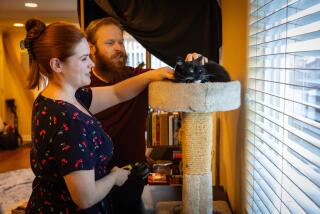Great Recession saw more 20-somethings living with their parents
If it sometimes seems as if almost every Southern Californian you know has had an adult child living at home recently, or knows someone who has, that may be because it’s true.
Three big swaths of Southern California, including greater Los Angeles and Long Beach, rank among the top 10 metropolitan areas in the U.S. for the proportion of 20-something adults who lived with their parents for at least a time during the Great Recession, a new study shows.
Nearly 1 in 3 25- to 29-year-olds in Southern California lived at home at some point between 2007 and 2009, according to the report released Wednesday by Ohio State sociologist Zhenchao Qian. That compares to 19% for that age group nationwide.
Young people across the country, especially those just entering the workforce, were hit hard by the recession, which ended officially in 2009 but whose painful effects still linger.
Qian’s research, based on an analysis of census data, shows that the trend of young adults staying with their parents occurred across the U.S. but was strongest in large metropolitan where high living costs and high unemployment came as a double whammy. The top 10 metropolitan areas on his ranking included New York, Miami, Honolulu and El Paso.
Those areas have other factors in common, including lower median incomes and lower levels of college attendance than in metro areas where young adults were less likely to stay in the nest — or bounce back into it.
Significantly, Qian said, the top 10 areas also tend to have large Latino, Asian or other racial or ethnic communities in which living with parents into adulthood is more common than among whites, although the numbers for whites also jumped during the recession.
Traditions of extended family living among Latinos, intergenerational obligations among Asians and strong kinship ties for African Americans may contribute to many of these young adults staying or returning home, said Qian, who chairs Ohio State’s sociology department. Delays in the age of marriage also played a role, he said.
Among young people aged 20 to 34, Native Americans had the highest percentage (30%) living with parents during the recession, Qian found. African Americans were next with 27%, followed by Asian Americans, with 26%. Latinos, with 24%, came next, followed by whites, at 23%.
Topping the list of metro areas nationwide was Bridgeport, Conn., where 34% of 25- to 29-year-olds lived with their parents at some point during the recession. The Los Angeles metro area, which includes Long Beach and Santa Ana, was tied for sixth with Oxnard-Thousand Oaks-Ventura. Each had 28% of young adults doubling up with parents in recent years. Metropolitan Riverside-San Bernardino-Ontario ranked 10th, with 26% of its young people living at home for a while.
Young men were much more likely than young women to live with their parents during the recession, Qian said. Among men between the ages of 20 to 34, 26% had lived at home in recent years, compared to 21% of women the same age, the study found. Among the reasons may be that men on average are two years older than women when they marry and that women were more likely than men to double up with relatives other than parents, he said.
But there may be another reason, Qian said, based on other recent research: “If sons go back home, they’re probably under fewer obligations to do housework than the daughters are.”
The major metro areas with the lowest percentages of young people living with parents included Des Moines; Raleigh, N.C.; and the Austin, Texas area. They tended to be fairly small in population and had relatively low unemployment among young people.
The study, based on census data from 1980 through 2009, is part of the US 2010 research project, which examines recent changes in American society.
More to Read
Start your day right
Sign up for Essential California for news, features and recommendations from the L.A. Times and beyond in your inbox six days a week.
You may occasionally receive promotional content from the Los Angeles Times.





